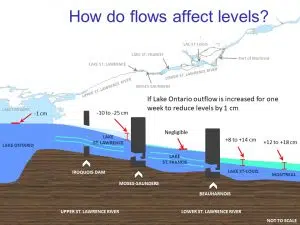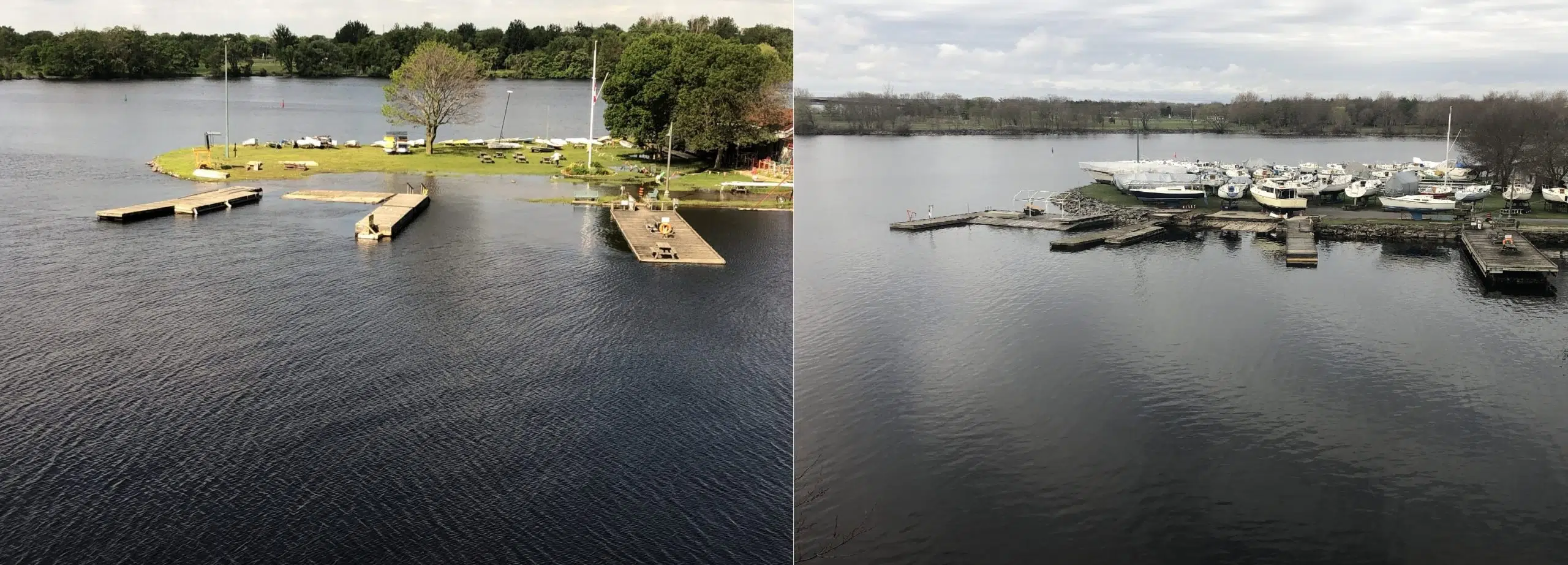Over the last several years high water levels in Lake Ontario and the Bay of Quinte have been the concern. Not in 2021.
The Lake Ontario- St.Lawrence River Board and International Joint Commission have announced that due to lower than average precipitation, and winter snowpack runoff, Lake Ontario and the Bay of Quinte are below seasonal levels.
Over the next three weeks, the board has announced they will reduce outflows into the St. Lawrence, keeping an additional six centimetres of water in Lake Ontario. One centimetre let out from Lake Ontario means about 12-18 centimetres by the Port of Montreal in the St.Lawrence River. SEE GRAPHIC BELOW
Officials say during this change at the dam in Cornwall, there will be some fluctuating levels, however no damage is expected.
In 2017 and 2019, there was major damage to shorelines along Lake Ontario and the Bay of Quinte due to high levels in the entire Great Lakes system, along with inflows to them.
So how do all the Great Lakes look?
Lake Superior – currently 20 centimetres above seasonal average, but 14 centimetres lower than this time in 2020.
Lake Michigan/Huron – currently 59 centimetres above seasonal average, but 34 centimetres below this time in 2020.
Lake Erie – 41 centimetres above seasonal average, but down 45 centimetres from 2020.
Lake Ontario – 27 centimetres below seasonal average, and down 72 centimetres from 2020.
 You can read the full media release below:
You can read the full media release below:
Lower than average precipitation and winter snowpack runoff have resulted in decreased inflows to Lake Ontario. The reduced inflows have resulted in lower water levels on Lake Ontario and the St. Lawrence River. In response to these conditions, the Board has decided to reduce outflows from Lake Ontario beginning on 10 April, 2021.
During January and February this year, the Board was deviating under authority granted by the International Joint Commission (IJC) to remove additional water from Lake Ontario as a result of the risk analysis in December 2020 showing approximately a 28% chance of water levels exceeding a damaging high water threshold in 2021. A total of 9.4 cm (3.7 in.) was removed from Lake Ontario to further reduce the risk of potentially damaging high water levels in late Spring and early Summer.
Due to the reduced spring runoff, the Board has decided to reduce outflows below those specified by the plan to restore the extra water removed during the winter to Lake Ontario at a rate of approximately 2 cm (0.8 in) of water to Lake Ontario per week for the next three weeks. After these 3 weeks, the Board will revert to plan-prescribed outflows.
This strategy will allow Lake Ontario and Lake St. Lawrence water levels to increase more than they would under plan-prescribed flows over the next few weeks. It now appears likely that Lake Ontario levels will remain below long-term average over the summer unless very wet weather occurs. Most forecast scenarios suggest that Lake Ontario levels will remain above critical low water level thresholds due to lower than average precipitation. Under this strategy, water levels in Lake St. Lawrence will experience short term increases as a result of its position as forebay of the Moses-Saunders Dam. However most forecast scenarios indicate dry conditions that will likely result in significantly below average Lake St. Lawrence levels this spring and summer.
This strategy is expected to have negligible impacts at Lake St. Louis near Montreal compared with the other strategies considered. Lake St. Louis levels may be up to 10 cm lower than they would be under plan-prescribed flows for the next few weeks. However, most forecast scenarios suggest that Lake St. Louis levels will remain above critical low-level thresholds for the spring and summer.
The Board will continue to monitor conditions closely through the summer. Should dry conditions persist, the Board will meet again regularly to discuss potential actions to adjust outflows.
Information on hydrologic conditions, water levels and outflows, including graphics and photos, are available on the Board’s website and posted to the Board’s Facebook page at https://www.facebook.com/InternationalLakeOntarioStLawrenceRiverBoard (English), and more detailed information is available on its website at https://www.ijc.org/en/loslrb.






